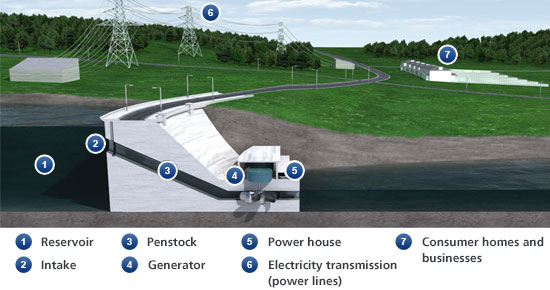A power plant that produces electricity by using flowing water to rotate a turbine is called hydro-power plant. The electricity produced by using the energy of falling water is called hydroelectricity. A hydro-power plant produces electricity as follows:

A hydroelectric power station converts the kinetic of flowing or falling water into electrical energy. Hydroelectric power can be generated on a small scale with a 'run-of-river' installation, which uses naturally flowing river water to turn one or more turbines, or on a large scale with a hydroelectric dam.
A hydroelectric dam straddles a river, blocking the water's progress downstream. Water collects on the upstream side of the dam, forming an artificial lake known as a reservoir (1). As more and more water collects in the reservoir, the level of water behind the dam rises to a large height. In this way, kinetic energy of the flowing river water is converted into the potential energy of water stored behind the dam. The reservoir becomes a sort of battery, storing energy that can be released a little at a time.
The reservoir's potential energy is converted back into kinetic energy by opening underwater gates, or intakes (2), in the dam. When an intake opens, the immense weight of the reservoir forces water through a channel called the penstock (3) towards a turbine. The water rushes past the turbine, hitting its blades and causing it to spin, converting some of the water's kinetic energy into mechanical energy. The water then finally flows out of the dam and continues its journey downstream.
A shaft connects the turbine to a generator (4), so when the turbine spins, so does the generator. The generator uses an electromagnetic field to convert this mechanical energy into electrical energy. As long as there is plenty of water in the reservoir, a hydroelectric dam can respond quickly to changes in demand for electricity. Opening and closing the intakes directly controls the amount of water flowing through the penstock, which determines the amount of electricity the dam is generating.
The turbine and generator are located in the dam's power house (5), which also houses a transformer. The transformer converts the electrical energy from the generator to a high voltage. The national grid uses high voltages to transmit electricity efficiently through the power lines (6) to the homes and businesses that need it (7).